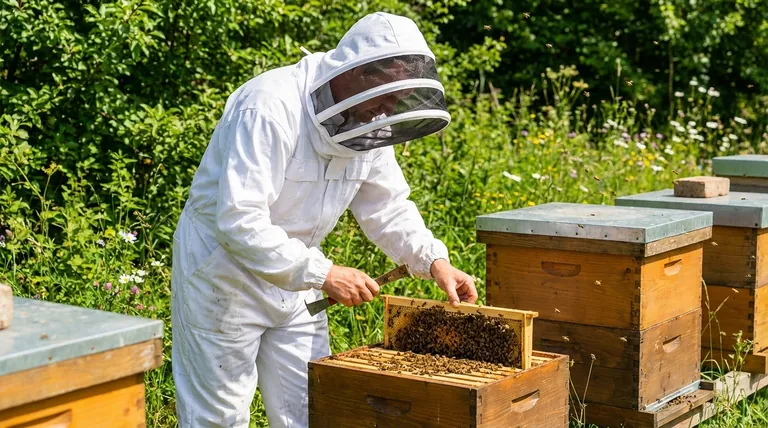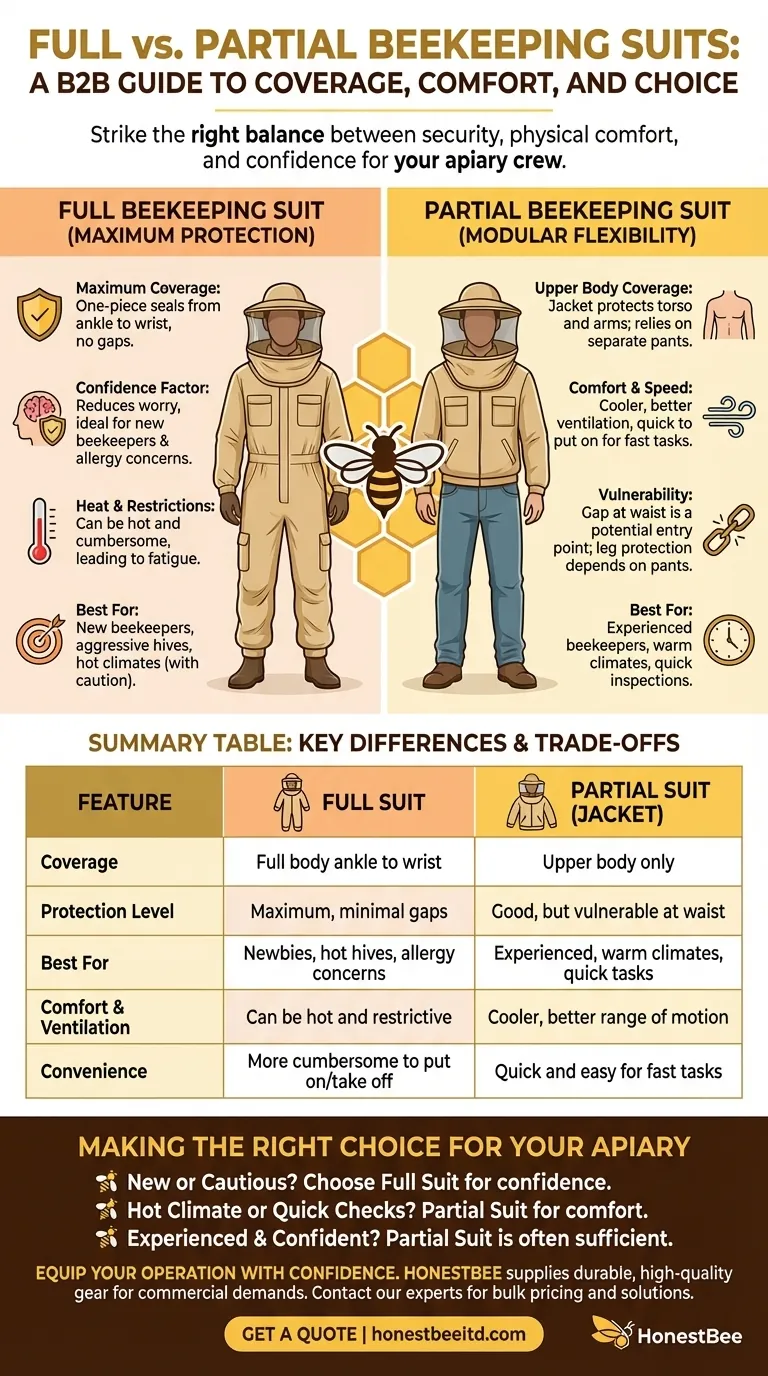The primary difference is coverage and convenience. A full beekeeping suit is a one-piece coverall that seals you from ankle to wrist, offering maximum protection. A partial suit, most commonly a beekeeping jacket, covers only your upper body and is paired with separate pants, providing more flexibility and comfort at the expense of complete coverage.
Choosing your protective gear is one of the first critical decisions in beekeeping. The choice is not simply about preventing stings, but about striking the correct balance between absolute security, physical comfort, and the confidence you need to work effectively.

Defining the Gear: Full vs. Partial Suits
The terminology can be confusing, but the distinction is straightforward and centers on whether the garment is a single piece or separate components.
The Full Beekeeping Suit: Maximum Protection
A full suit is an all-in-one garment, similar to a mechanic's coverall, designed specifically for beekeeping. It integrates pants and a top into a single piece.
These suits feature long sleeves and legs with strong elastic or Velcro closures at the wrists and ankles. This design creates a nearly impenetrable barrier, as there is no gap at the waist for bees to enter. Most full suits come with a veil attached by a zipper.
The Partial Beekeeping Suit: Modular Flexibility
A partial suit is not a pre-packaged set but rather an approach. The most common setup is a beekeeping jacket paired with durable, thick pants like heavy denim jeans.
The jacket provides the same upper-body protection as a full suit, including long sleeves and an integrated veil. However, it relies on you to provide lower-body protection, and it creates a potential entry point for bees at the waistline where the jacket ends and your pants begin.
Understanding the Trade-offs: Protection vs. Practicality
The right choice depends entirely on your personal comfort level, your climate, and the nature of your beekeeping tasks.
Why Choose a Full Suit? The Confidence Factor
A full suit is the gold standard for protection, making it the default recommendation for new beekeepers. The psychological security it provides is invaluable when you are learning to read bee behavior.
It minimizes worry about stings, allowing you to focus on your hive inspections. This is also the most prudent choice if you are unsure whether you have a bee sting allergy.
The Downsides of Full Coverage
The primary drawback of a full suit is heat. The complete coverage and heavy fabric can become extremely hot and uncomfortable during summer inspections, leading to fatigue.
They are also more cumbersome to put on and take off compared to a simple jacket. Some argue that the sense of invulnerability can also lead to overconfidence and less careful handling of the bees.
Why Choose a Partial Suit? Comfort and Speed
A beekeeping jacket is significantly cooler, as it allows for more ventilation. It's also far more convenient for quick tasks, like refilling a feeder or a brief hive check.
Many experienced beekeepers prefer a jacket because it offers a better range of motion and is less restrictive. They have the experience to manage the minimal risk of a sting to the lower body.
The Inherent Risk of Partial Coverage
The obvious trade-off with a partial suit is a reduction in total protection. The gap between the bottom of the jacket and the top of your pants is the primary vulnerability.
Furthermore, the protection for your legs is only as good as the pants you choose to wear. Thin trousers offer little defense against a determined bee.
Making the Right Choice for Your Apiary
Your decision should be based on a realistic assessment of your experience, temperament, and local climate.
- If you are a new beekeeper or have any fear of bees: A full suit is the most prudent choice to build confidence and ensure maximum safety.
- If you live in a hot climate or primarily perform quick inspections: A high-quality beekeeping jacket offers a more comfortable and practical experience.
- If you are an experienced beekeeper confident in your movements: A partial suit is often sufficient, as you are more familiar with bee behavior and calm hive management.
Ultimately, the best protective gear is the gear you will wear consistently, allowing you to work calmly and effectively with your bees.
Summary Table:
| Feature | Full Suit | Partial Suit (Jacket) |
|---|---|---|
| Coverage | Full body (ankle to wrist) | Upper body only |
| Protection Level | Maximum, minimal gaps | Good, but vulnerable at waist |
| Best For | New beekeepers, hot hives, allergy concerns | Experienced beekeepers, warm climates, quick inspections |
| Comfort & Ventilation | Can be hot and restrictive | Cooler and offers better range of motion |
| Convenience | More cumbersome to put on/take off | Quick and easy to put on for fast tasks |
Equip Your Beekeeping Operation with Confidence
Whether you manage a few hives or a large commercial apiary, having the right protective gear is non-negotiable for safety and productivity. HONESTBEE supplies durable, high-quality beekeeping suits and jackets designed for the demands of commercial beekeepers and equipment distributors.
We understand that your choice impacts your crew's comfort, confidence, and efficiency. Let us help you select the optimal gear for your specific climate and operational needs.
Get in touch with our experts today to discuss bulk pricing and find the perfect solution for your business.
Visual Guide

Related Products
- Cotton Beekeeping Suit and Round Hat with Veil Bee Keeper Protective Gear
- White Beekeeping Protective Suit and Hat with Fencing Veil for Beekeepers
- Heavy Duty Cowboy Beekeeper Hat with Visibility Veil Outdoor Professional Beekeeping Protective Gear
- Beekeeper Cowboy Hat and Veil for Beekeeping
- Professional Beekeeping Suit for Kids and Girls Childrens Bee Keeper Suit
People Also Ask
- What factors should be considered when choosing a beekeeping suit? Balance Safety, Comfort & Performance
- Why is white the predominant color in bee suit designs? | Key to Hive Calm & Beekeeper Safety
- What are bee suits made of? Choosing the Right Material for Maximum Protection & Comfort
- How should a bee suit be cleaned? Protect Your Investment and Ensure Apiary Safety
- What are the benefits of a fully ventilated beekeeping suit? Stay Cool and Protected in Hot Climates



















